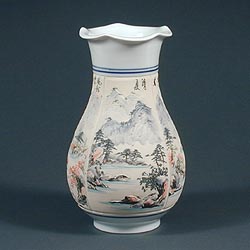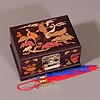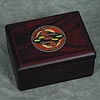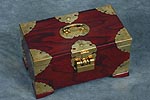Caring for Korean Celadon and Lacquered Boxes
Celadon, Baek-ja (white porcelain), and Bun-cheong (brown porcelain)
Well made Korean celadon needs surprisingly little care and can last for thousands of years with little change in its appearance. Some of the Koryo era celadon recovered from tombs in the early 1900's had been buried for nearly 900 years yet pieces that were protected from direct contact with water, looked as if they were new. Other pieces, that had been exposed to water showed some fading in the color of the glaze and some pock-marking on the surface, but overall, had survived quite well.
Celadon kept indoors and protected from the sun and
rain, will hold up even better. In order to keep your celadon looking new, it
need simply be wiped with a moist cloth occasionally to remove any buildup of
dust and kept out of direct sunlight to help protect the glaze from fading. The
smooth surface of the celadon glaze is virtually impervious to damage from a
normal environment.
|
Baek-ja can have either a slightly rough surface or a smooth surface like celadon. Those pieces with a smooth surface can be cared for in the same way as celadon, and simply wiped with a moist cloth to remove any buildup of dust, and also kept out of direct sunlight. Baek-ja with a rough surface such as the Tulip-shaped Four Season Jar shown at right, should be dusted lightly with a feather duster or an air-can duster to remove the dust from the surface. Wiping with a moist cloth may tend to embed the dust into the rough surface of the jar. After some period of time, should the surface get dust embedded in it, it can be removed by rinsing the surface with warm water and a very mild soap. Bun-cheong generally has a rough surface and can have the same problem with dust buildup as Baek-ja. Bun-cheong should be dusted lightly with a feather duster or an air-can duster to remove the dust from the surface and after some period of time, should the surface get dust embedded in it, it can be removed by rinsing the surface with warm water and a very mild soap. |
|
Lacquered Boxes
There are generally four types of surfaces on the lacquered boxes made in Korea. Either the smooth glossy finish found on most of the black music boxes, the inlaid wood finish seen on some of the jewelry boxes, a lightly lacquered wood finish, or a combination of a glossy finish with brass hinges and accoutrements.
|
Of the four, the smooth glossy is the easiest to maintain and can simply be wiped with a dry cloth to remove dust and occasionally, polished with a furniture polish product that contains a wax such as Pledge. |
|
|
Both the inlaid wood boxes and the lightly lacquered boxes should be wiped with a moist cloth and should a large buildup of dust appear after several years, they can be gently cleaned with a cloth moistened with a mild soap solution. Do not use a furniture polish on these boxes as it will change the appearance of the surface and make them appear too glossy. |
|
|
Those boxes with both a lacquered finish and brass accoutrements can be wiped with a dry cloth for regular cleaning and alternately, polished with a furniture polish product and a brass cleaning product such as Brasso can be used to clean the brass portions. Brasso will not harm the lacquered finish of the box. |
|




